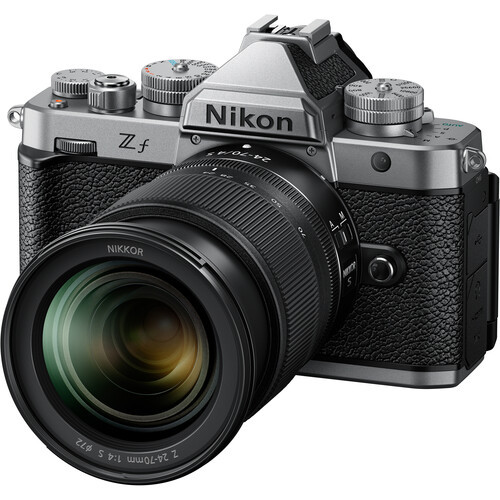More speed, more versatility, more performance, the Nikon Z 6II is an updated take on the all-rounder mirrorless camera designed for high-end photo and video applications. Despite the wealth of upgrades, the Z 6II retains its familiar form factor and prized image quality to benefit working multimedia image-makers.
Revolving around a 24.5MP BSI CMOS sensor and dual EXPEED 6 image processors, the Z 6II is characterized by an increased buffer depth and faster continuous shooting rate, up to 14 fps with single-point AF or 12 fps shooting in other focusing modes. Video recording at UHD 4K 30p is possible, or up to FHD 120p for slow-motion output, and external recording gains 10-bit out along with N-Log and HLG (HDR) support. The sensor also suits working in a variety of lighting conditions, with sensitivity from ISO 100-51200, and in-body 5-axis Vibration Reduction reduces the appearance of camera shake for sharper handheld shooting. Additionally, the sensor also incorporates a 273-point phase-detection AF system, which now supports Eye-Detect AF in Wide-Area AF modes and during movie recording, and permits focusing in low-light down to -4.5 EV.
Balancing the imaging, the Z 6II retains its overall physical design, however it has been updated with a new dual memory card slot interface to hold one CFexpress Type B card and one SD UHS-II card for more flexible storage. Both a high-res 3.6m-dot OLED EVF and rear 3.2" 2.1m-dot tilting touchscreen LCD lend versatility to image composition and playback, and SnapBridge wireless connectivity can be used for remote camera control, image sharing to a mobile device, and even over-the-air firmware updates.
Second Generation Z
- Dual EXPEED 6 image processors offer increased buffer performance, a faster 14 fps continuous shooting rate, and noticeably reduced blackout times in the viewfinder.
- Updated autofocus now includes Eye and Face Detection for both humans and animals in the Wide-Area AF mode, for both photo and video recording.
- Timed long exposure shooting is now possible for up to 900 seconds (15 minutes) without the need of an external remote.
- Dual memory card slots offer more flexible file storage capabilities; one CFexpress Type B and one SD UHS-II slot permit overflow, segregated, and repetitive saving options.
- USB Type-C port permits in-camera charging or continuous power for on-the-go charging or extended shooting times.
- The rotation direction of the focus ring on lenses can be switched to suit one's familiarity.
- Support for HDR (HLG) mode when recording externally gives instant HDR-suitable video files for immediate playback. N-Log is also available for enhanced control during post-production and grading, too.
- Future firmware update will add UHD 4K 60p recording, in addition to the current 30p frame rate.
- Eligible for an optional ProRes RAW upgrade, enabling the camera to output ProRes RAW footage to a compatible Atomos external recorder. This upgrade provides greater color grading flexibility with the ProRes codec along with the ability to output uncompressed 12-bit raw footage over HDMI. This upgrade will be available in early 2021.
- The SnapBridge wireless connectivity can be used to update the camera's firmware, instead of relying on a memory card-based system of updating.
- Updated creative shooting modes include Multiple Exposure, 20 different Picture Control settings, and in-camera Timelapse recording. There is also a Focus Shift mode for recording up to 300 sequential frames with the focus position shifted between exposures for focus stacking applications.
- Compatible with optional MB-N11 Power Battery Pack for additional battery life and improved handling.
24.5MP FX-Format BSI CMOS Sensor and Dual EXPEED 6 Processors
UHD 4K Video Recording
Advanced video functionalities have been added with the Z 6II, including the N-Log gamma for capturing flat-looking footage that maximizes dynamic range and HLG (HDR) for recording HDR-ready footage. Other additions are the ability to output high-quality 10-bit data over HDMI and an Electronic VR function for smooth handheld shooting. Focus Peaking can be used to benefit manual focus control and a Zebra Stripes option is also available to help detect over-exposed areas within the frame. Audio recording can be handled using the built-in stereo microphone or an optional external mic can be added via the 3.5mm stereo jack for greater control over quality, and live monitoring is possible via the headphone jack.
273-Point Phase-Detect AF System
Vibration Reduction
Body Design
- A large 3.2" 2.1m-dot LCD screen is available for bright, clear, and vivid image playback and live view shooting. The screen has a tilting design to benefit working from both high and low angles, and it is also a touchscreen for more intuitive operation, navigation, and settings control.
- A 3.6m-dot OLED electronic finder is present for comfortable eye-level viewing. It has a high 0.80x magnification and uses NIKKOR optics to guarantee a sharp, clear image. The finder also has a fluorine coating for easier cleaning.
- The top panel of the Z 6II is configured with a dot-matrix OLED. This low-energy display provides quick access to important camera settings.
- Configured with one CFexpress Type B/XQD memory card slot and one UHS-II SD card slot, flexible file storage is possible with the option to use repetitive, overflow, or segregated storage methods.
- A robust magnesium alloy chassis is both dust- and weather-resistant to benefit working in harsh climates and inclement conditions.
- The ergonomic grip and overall form factor is shaped to benefit handling for extended periods of time and is further accentuated by an anti-slip material and a joystick for seamless settings and focus point selection.
- Built-in SnapBridge connectivity to enable seamless transfer of low-resolution imagery as well as remote shooting capabilities. BLE (Bluetooth Low Energy) and Wi-Fi enables communication between the camera and a smart device and, additionally, the mobile device can remotely trigger the shutter and display a live view image from the camera to enable working from a distance. Additionally, SnapBridge can also be used as an easier method of updating the camera's firmware.










